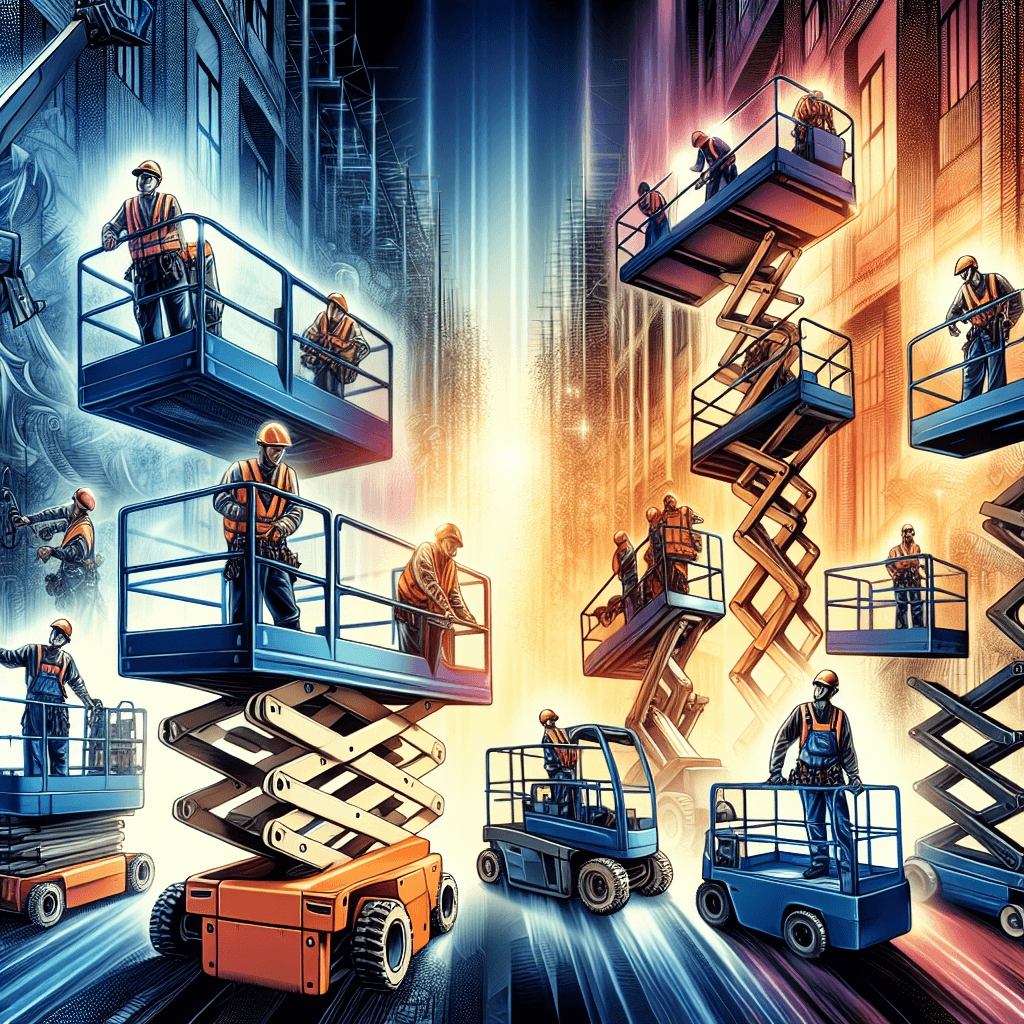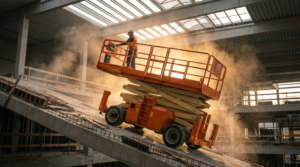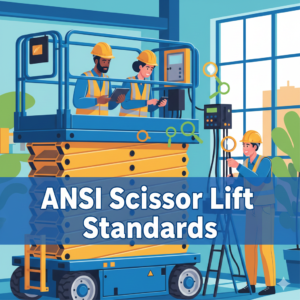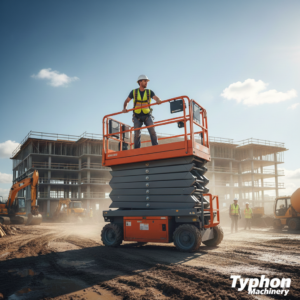Introduction to Scissor Lifts in Construction
Construction sites are bustling hubs of activity that demand efficiency, safety, and precision. Enter the scissor lift—a versatile piece of machinery that has revolutionized how tasks are performed at elevated heights. Scissor lifts are mechanical platforms that can be raised or lowered to access hard-to-reach areas. They are designed with a crisscrossing (scissor-like) structure, which extends when the platform is lifted.
In the construction industry, scissor lifts have become indispensable tools. They allow workers to perform various tasks, from installing electrical systems to painting high walls, without the need for cumbersome scaffolding. This blog post will explore the types, applications, safety guidelines, and future trends of scissor lifts in construction, providing valuable insights for construction professionals, project managers, and safety managers.
An aerial lift called a scissor lift gives workers a secure, consistent enclosure and a rising platform to enable them to do exact tasks at great heights. A scissor lift is a kind of construction lift, which is equipment fitted with a platform to raise cargo and personnel to high places. Although there are some important variations between them, construction lifts include many varieties of scissor lifts and boom lifts.
For jobs where height is not a factor, a scissor lift is a more logical and reasonably priced choice, as it can raise many personnel at once while just moving up and down. Fuel type, use, and size differ across scissor lifts. On the workplace, these are the five primary forms of scissor lifts observed.
Types and Features of Scissor Lifts
Hydraulic Scissor Lifts
Either hand-operated or engine-driven hydraulic systems run hydraulic scissor lifts. The hydraulic oil’s fluctuating pressure in the machine facilitates lift operation and platform movement down and up.
A hydraulic scissor lift is a straightforward choice when you have lifting demands, as users are not obliged to undergo much training since it is really easy to operate.
Hydraulic scissor lifts are much slower in colder conditions as oil becomes more viscous at lower temperatures. Although more recent versions have solved this problem, hydraulic scissor lifts are usually suitable for applications where horsepower and speed are not top concerns.
Diesel Scissor Lifts
On building projects, diesel scissor lifts are among the most often utilized ones. With its trademark cross-braced structure, they can climb 30 feet; advanced versions stretch as high as 60 feet.
These elevators are loud and spew emissions into the surroundings as diesel fuel runs them. They are therefore saved for outside building sites or places where ventilation exists and noise may be released. Their big aerial platform comes from their heavy design as well.
Electric Scissor Lifts
Another often used aerial platform equipment are electric scissor lifts. An electric scissor lift uses a quiet, powered motor system instead of burning fuel. Electric scissor lifts provide a better answer for inside environments, which sometimes lack enough ventilation, as they do not produce fumes or noise. Smaller environments would find these devices ideal as they are also less heavy than their diesel equivalents.
Electric scissor lifts are ideal for indoor construction projects. They are eco-friendly and quiet because they run on batteries. These lifts are perfect for tasks that require precision and a cleaner work environment, such as electrical installations or interior finishing. The key feature of electric scissor lifts is their ability to operate efficiently in spaces with limited ventilation.
Rough Terrain Scissor Lifts
Scissor lifts on rough terrain also have only outside use. They include heavy-duty tires, a large weight capacity, and extra safety devices like arrestors and fall restraints. This makes them perfect for projects running in bad weather and for construction locations with uneven ground and hills.
Up to 50 feet in height and widths of up to 10 feet may be achieved using rough terrain scissor lifts. Diesel, gasoline, liquid propane or dual fuels run the machines.
On the other hand, rough terrain scissor lifts are designed for outdoor use. They are equipped with robust tires and a powerful engine, allowing them to maneuver on uneven surfaces. These lifts are essential for heavy-duty construction tasks, such as roofing or installing external structures. Their stability and durability make them reliable even in the most challenging conditions.
Pneumatic Scissor Lifts
Using air pressure as its lifting mechanism, pneumatic scissor lifts Looking to reduce their carbon footprint, this lift is a more sustainable choice than conventional lifts as it does not release dangerous fumes or byproducts into the environment.
To raise and lower the platform, a pneumatic scissor lift vacuumes and compresses atmospheric air. Although they lack gasoline, they do not provide as much power as a rough terrain or diesel lift; still, the apparatus may be utilized practically anywhere, including interior facilities.
Key Features to Consider
When choosing a scissor lift for a construction project, several features should be considered:
- Load Capacity: Ensure the lift can handle the weight of the workers and materials.
- Platform Size: A larger platform can accommodate more workers and tools.
- Height Reach: The lift should reach the necessary height for the task.
- Safety Features: Look for models with safety rails, emergency stop buttons, and non-slip surfaces.
Applications of Scissor Lifts in Construction
Electrical Installations
Scissor lifts are extensively used in electrical installations. Electricians can easily access ceiling-mounted fixtures, run cables, and install lighting systems. The lift’s stability ensures that they can work safely and efficiently, reducing the time needed to complete the installation.
Exterior Painting and Maintenance
For exterior painting and maintenance, rough terrain scissor lifts are invaluable. Painters can reach high walls and roofs without the need for ladders or scaffolding. Scissor lifts provide a stable platform, allowing for precise and even painting. Additionally, maintenance workers can use these lifts to clean windows, repair gutters, and inspect building exteriors.
Case Study Example
In a recent construction project in downtown Seattle, a team of electricians used electric scissor lifts to install a complex lighting system in a new office building. The lifts allowed them to work quickly and safely, completing the installation ahead of schedule and under budget.
Safety Guidelines and Best Practices
Essential Safety Guidelines
Operating scissor lifts safely is paramount in any construction project. Here are some essential safety guidelines:
- Pre-Operational Checks: Conduct thorough inspections of the lift before use, checking for any mechanical issues or defects.
- Proper Training: Ensure all operators are trained and certified to use scissor lifts. They should understand the machine’s controls and safety features.
- Avoiding Overloading: Never exceed the lift’s load capacity. Overloading can lead to accidents and equipment damage.
- Stable Ground: Always position the lift on stable ground to prevent tipping. Use stabilizers if necessary.
Importance of Training and Certification
Training and certification are crucial for scissor lift operators. Certified operators are well-versed in best practices and safety protocols, significantly reducing the risk of accidents. Many organizations offer comprehensive training programs that cover the operation, maintenance, and emergency procedures related to scissor lifts.
Environmental and Economic Benefits
Greener Construction Industry
Scissor lifts, particularly electric models, contribute to a greener construction industry. They produce zero emissions, reducing the project’s carbon footprint. Additionally, their efficient design minimizes energy consumption, making them an eco-friendly choice for construction professionals committed to sustainability.
Cost-Efficiency and Time-Saving Benefits
Using scissor lifts can lead to significant cost savings. These lifts streamline tasks that would otherwise require multiple pieces of equipment or extensive manpower. For example, a single scissor lift can replace the need for scaffolding, ladders, and additional labor. This efficiency translates to faster project completion times and lower overall costs.
Future Trends and Innovations
Emerging Technologies
The future of scissor lifts in construction looks promising, with several emerging technologies set to enhance their functionality. For instance, some manufacturers are developing lifts with advanced telematic systems. These systems provide real-time data on the lift’s performance, allowing for predictive maintenance and reducing downtime.
Innovations in Lift Design
Innovations in lift design are also on the horizon. Lightweight materials, such as high-strength aluminum, are being used to construct more efficient and durable scissor lifts. Additionally, hybrid models that combine electric and hydraulic power are being developed to offer the best of both worlds—eco-friendliness and robust performance.
Predictions for the Future
Experts predict that scissor lifts will become even more integral to construction projects. As urbanization continues to rise, the demand for efficient, safe, and sustainable construction solutions will grow. Scissor lifts, with their versatility and advanced features, are well-positioned to meet this demand.
Scissor Lift FAQ’s
Keep reading to get more information with the answers to these often asked questions if you are considering your alternatives and wondering whether a scissor lift is right for you.
What Is the Difference Between a Scissor Lift and a Boom Lift?
Seeing a scissor lift and a boom lift can help you quickly distinguish between them. For instance, although a boom lift may travel forward, backward, left and right, a scissor lift platform only goes up and down. One is better for a job than the other, however, depending on certain other basic factors; vice versa.
One finds in a scissor lift:
- A larger platform
- The capacity to just travel vertically
- More stability
- Increased weight capacity
- more applications for indoor chores
One has from a boom lift:
- a smaller platform
- more exact maneuverability
- An extended arm reach
- A smaller weight capacity
- More applications in outdoor work.
How Do You Operate a Scissor Lift?
Although running a scissor lift is a simple chore, you should always get acquainted with all its settings and follow all safety procedures. Operating a scissor lift in six stages may be quickly broken down here:
Get used to the controls. Review the manufacturer’s guide and get acquainted with the model you are working on before you begin. Examine the control panel and note its many purposes, including those of joystick and emergency stop buttons.
Exercise safety measures and do a safety test. Perform a safety check and don the appropriate safety gear. Verify the lift’s general state of operation. Tell a supervisor right away if you see leaks, breakdowns, or other damage. Should no safety issues arise, you might be free to keep running.
Start the scissor lift. To run the controls, disengage the emergency stop buttons.
Orient the scissor lift. You will have to turn on “drive mode” to properly position your scissor lift. Once the driving mode is turned on, go forward, backwards, left, and right using the joystick.
Place the platform. Once you’re in the right region, turn off drive mode and use the joystick to vary its height. Before you start elevating the platform, look for any overhead impediments and mark where you should stop. Pull back on the joystick to raise the platform, then forward to drop it.
Turn off the scissor lift upon completion. Make sure that the platform has been lowered to its lowest position after you complete using the lift, then activate any safety devices. The emergency stop button will let you securely close the elevator. Make sure you always plug it in to recharge or refuel it at the end of the day so it is ready for the next.
What are OSHA Standards for Operating a Scissor Lift?
The Occupational Safety and Health Administration (OSHA) clearly governs using or working close to a scissor lift. Following the following scissor lift safety guidelines and recommendations falls on employers:
- Guardrails on scissor lifts help to stop falls.
- Make sure scissor lifts are steady and won’t tip over or collapse.
- Arrange the scissor lift so that it poses no electrocution or crushing risks.
- Make sure the person gets electrical training if the employment calls for labor close to an electrical source.
- Employers have to keep scissor lifts in constant maintenance to guarantee their safety.
- Companies have to offer employees instruction on safe working with or near scissor lifts.
Visit the OSHA website for the most current and accurate material.
What Kind of Scissor Lift Do You Need for Your Project?
Satisfying your project requirements depends on selecting the correct scissor lift. Apart from the topographical conditions and power supply described in the scissor lift types, you need to additionally take into account elements such as the weight of what you want to lift, lift strength and height, load stability, loading technique, and desired platform size.
These elements interact and need to all be taken into account when choosing a scissor lift. See our advice on determining which scissor lift suits you for more details.
BigRentz offers everything you need—scissor lifts, boom lifts, or any other aerial tool. We provide many kinds of scissor lifts and more available for rental. And BigRentz is here to help you do your task quickly with sites throughout 50 states and simple, hassle-free delivery to your workplace.
View our choices of scissor lifts and other aerial lifts for hire close by!
Conclusion
Scissor lifts have undeniably transformed the construction industry, offering a blend of efficiency, safety, and versatility. From indoor electrical installations to outdoor maintenance tasks, these lifts are indispensable tools for modern construction projects. By adhering to safety guidelines and staying updated on emerging trends, construction professionals can maximize the benefits of scissor lifts.
If you’re considering integrating scissor lifts into your next construction project, now is the time to act. Explore the various models and features available, and choose the lift that best suits your needs. Don’t forget to share this post with your colleagues and fellow construction professionals—together, we can elevate the industry to new heights.





